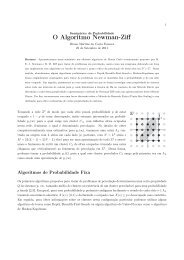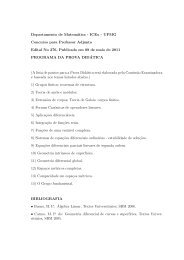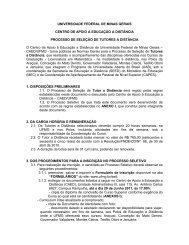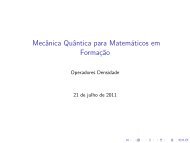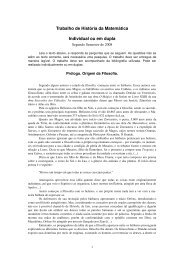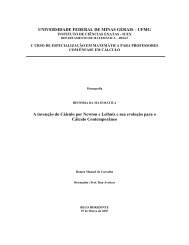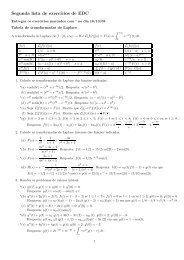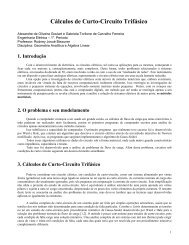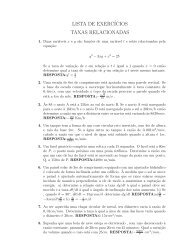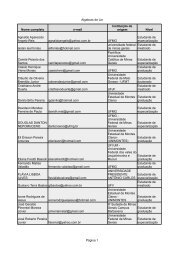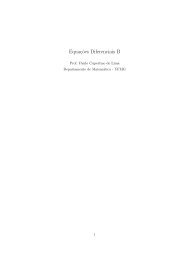Autovalores do Laplaciano - Departamento de Matemática - UFMG
Autovalores do Laplaciano - Departamento de Matemática - UFMG
Autovalores do Laplaciano - Departamento de Matemática - UFMG
You also want an ePaper? Increase the reach of your titles
YUMPU automatically turns print PDFs into web optimized ePapers that Google loves.
Rodney Josué Biezuner 26<br />
possui um número infinito enumerável <strong>de</strong> autovalores<br />
tais que<br />
e autofunções {uj} que satisfazem<br />
0 = λ0 λ1 λ2 . . . λj . . .<br />
∂u<br />
∂η<br />
λj → ∞,<br />
= 0 sobre ∂Ω<br />
e constituem um sistema ortonormal completo para L 2 (Ω), isto é,<br />
para to<strong>do</strong> v ∈ L 2 (Ω). Em particular,<br />
Além disso, para to<strong>do</strong> v ∈ W 1,2 (Ω) vale<br />
v =<br />
v 2<br />
L 2 (Ω) =<br />
∇v 2<br />
L 2 (Ω) =<br />
∞<br />
i=1<br />
∞<br />
i=1<br />
∞<br />
i=1<br />
αiui<br />
〈v, ui〉 2<br />
L 2 (Ω) .<br />
λi 〈v, ui〉 2<br />
L 2 (Ω) .<br />
Na <strong>de</strong>monstração <strong>do</strong> Teorema 1.14 usamos o princípio <strong>de</strong> Rayleigh para obter o primeiro autovalor<br />
<strong>do</strong> laplaciano como o mínimo <strong>do</strong> funcional <strong>de</strong> Rayleigh. Como os autovalores <strong>do</strong> laplaciano formam uma<br />
seqüência infinita que cresce arbitrariamente em módulo, o funcional <strong>de</strong> Rayleigh para o laplaciano não<br />
possui um máximo. Entretanto, da mesma forma que no caso <strong>de</strong> opera<strong>do</strong>res lineares em dimensão finita,<br />
po<strong>de</strong>mos também <strong>de</strong>rivar um princípio <strong>de</strong> minimax para obter os <strong>de</strong>mais autovalores <strong>do</strong> laplaciano:<br />
1.16 Teorema. Seja Ω ⊂ R n um aberto limita<strong>do</strong>. Sejam<br />
0 < λ1 λ2 . . . λj . . .<br />
os autovalores <strong>do</strong> laplaciano com condição <strong>de</strong> Dirichlet:<br />
−∆u = λu em Ω, u ∈ W 1,2<br />
0 (Ω) .<br />
Então, se Lj <strong>de</strong>nota o conjunto <strong>do</strong>s subespaços vetoriais <strong>de</strong> W 1,2<br />
0 (Ω) <strong>de</strong> dimensão j, temos<br />
ou, dualmente,<br />
λj = min<br />
L∈Lj<br />
λj = max<br />
L∈Lj−1<br />
⎛<br />
⎝ max<br />
u∈L<br />
u=1<br />
⎛<br />
⎝ min<br />
u⊥L<br />
u=1<br />
〈∇u, ∇u〉 L 2 (Ω)<br />
〈∇u, ∇u〉 L 2 (Ω)<br />
⎞<br />
⎠ = min<br />
L∈Lj<br />
⎞<br />
⎛<br />
⎠ = max<br />
L∈Lj−1<br />
⎝max<br />
u∈L<br />
u=0<br />
⎛<br />
⎝min<br />
u⊥L<br />
u=0<br />
〈∇u, ∇u〉 L 2 (Ω)<br />
u 2<br />
L 2 (Ω)<br />
〈∇u, ∇u〉 L 2 (Ω)<br />
u 2<br />
L 2 (Ω)<br />
⎞<br />
⎠ (1.20)<br />
⎞<br />
⎠ . (1.21)<br />
O resulta<strong>do</strong> análogo vale para os autovalores <strong>do</strong> laplaciano com condição <strong>de</strong> Neumann trocan<strong>do</strong>-se<br />
W 1,2<br />
0 (Ω) por W 1,2 (Ω) e λj por λj−1.




